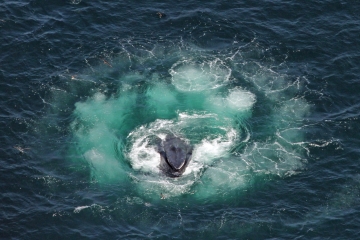SATS print 233_360 px width.jpg

A humpback whale creates an intricate bubble net to catch lots of tiny crustaceans. Credit: Christin Khan, NOAA/NEFSC
Sea otters, dolphins, crows, elephants, octopuses, crocodiles—these animals, like humans, use tools for a variety of activities, from eating and drinking, to grooming and play, to combat and communication. But far fewer animals are known to manufacture and modify the tools, rather than simply using what they come across in their environment. And now, humpback whales are part of this much smaller group of “tool wielders.”
Researchers have long known that humpback whales use “bubble-nets”—curtains made of blown bubbles—to catch the tiny crustaceans they feed on. But new research reveals just how sophisticated the making of these nets is and how the whales continually adjust and control them to ensure they catch as many prey as possible. Scientists at research institutes in Hawaii and Alaska wanted to find out how Alaskan populations of humpback whales, which spend their winters in Hawaii, manage to catch enough food during the Alaskan summer and fall to last them through the end of the year.
Biologists used specialized instruments attached to the whales to study the whales’ underwater behaviors and drones to watch from above the water’s surface. They discovered that the whales create the nets by blowing bubbles in strategic patterns with layers of internal rings. The whales control the number of rings, how large and deep the net is, and even the spacing between bubbles, thereby allowing them to catch up to seven times more krill on a single dive that they otherwise would. Reducing the number of dives conserves energy, and cooperative bubble-netting further lets them snare more food with less effort. Observing these hunting tactics in action, scientists saw how the whales consumed enough calories to make the long trip south for winter.


